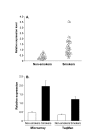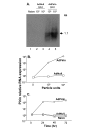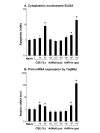Upregulation of pirin expression by chronic cigarette smoking is associated with bronchial epithelial cell apoptosis
- PMID: 17288615
- PMCID: PMC1805431
- DOI: 10.1186/1465-9921-8-10
Upregulation of pirin expression by chronic cigarette smoking is associated with bronchial epithelial cell apoptosis
Abstract
Background: Cigarette smoke disrupts the protective barrier established by the airway epithelium through direct damage to the epithelial cells, leading to cell death. Since the morphology of the airway epithelium of smokers does not typically demonstrate necrosis, the most likely mechanism for epithelial cell death in response to cigarette smoke is apoptosis. We hypothesized that cigarette smoke directly up-regulates expression of apoptotic genes, which could play a role in airway epithelial apoptosis.
Methods: Microarray analysis of airway epithelium obtained by bronchoscopy on matched cohorts of 13 phenotypically normal smokers and 9 non-smokers was used to identify specific genes modulated by smoking that were associated with apoptosis. Among the up-regulated apoptotic genes was pirin (3.1-fold, p < 0.002), an iron-binding nuclear protein and transcription cofactor. In vitro studies using human bronchial cells exposed to cigarette smoke extract (CSE) and an adenovirus vector encoding the pirin cDNA (AdPirin) were performed to test the direct effect of cigarette smoke on pirin expression and the effect of pirin expression on apoptosis.
Results: Quantitative TaqMan RT-PCR confirmed a 2-fold increase in pirin expression in the airway epithelium of smokers compared to non-smokers (p < 0.02). CSE applied to primary human bronchial epithelial cell cultures demonstrated that pirin mRNA levels increase in a time-and concentration-dependent manner (p < 0.03, all conditions compared to controls). Overexpression of pirin, using the vector AdPirin, in human bronchial epithelial cells was associated with an increase in the number of apoptotic cells assessed by both TUNEL assay (5-fold, p < 0.01) and ELISA for cytoplasmic nucleosomes (19.3-fold, p < 0.01) compared to control adenovirus vector.
Conclusion: These observations suggest that up-regulation of pirin may represent one mechanism by which cigarette smoke induces apoptosis in the airway epithelium, an observation that has implications for the pathogenesis of cigarette smoke-induced diseases.
Figures





References
-
- Mills PR, Davies RJ, Devalia JL. Airway epithelial cells, cytokines, and pollutants. Am J Respir Crit Care Med. 1999;160:S38–S43. - PubMed
-
- Maestrelli P, Saetta M, Mapp CE, Fabbri LM. Remodeling in response to infection and injury. Airway inflammation and hypersecretion of mucus in smoking subjects with chronic obstructive pulmonary disease. Am J Respir Crit Care Med. 2001;164:S76–S80. - PubMed
-
- Spurzem JR, Rennard SI. In: Asthma and COPD. Barns P, Drazen J, Rennard S, Thompson N, editor. Amsterdam; 2002. p. 145.
Publication types
MeSH terms
Substances
Grants and funding
LinkOut - more resources
Full Text Sources
Other Literature Sources
Molecular Biology Databases

